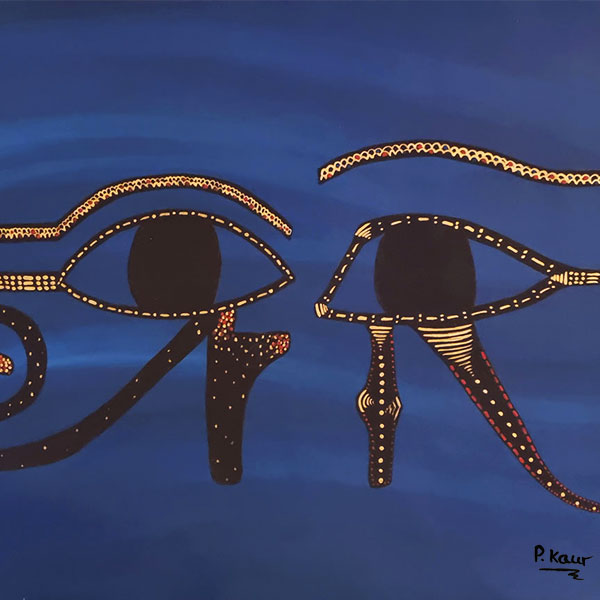Ancient Egypt has an impressive 3000 year history. Its geography allowed the civilisation to flourish relatively undisturbed from foreign invaders, which meant that their religion and culture remained very strong. Even some foreign rulers sought to uphold elements of the Ancient Egyptian religion and culture rather than bombard the civilisation with their own beliefs and customs.
There are in total 31 dynasties of Ancient Egypt, followed by 300 years of Ptolemaic Egypt finishing with the famous Cleopatra VII and then Roman Egypt.
Early Egypt
Ancient Egypt as we recognise it began around 3100 BCE when the pharaoh Narmer united Upper and Lower Egypt. From this would emerge the Old Kingdom and the Golden Age of Pyramids, when the great pyramids at Giza were constructed.
Before this, Egypt was full of local villages along the banks of the Nile for thousands of years
Intermediate Periods and The Middle Kingdom
Intermediate periods were the periods in between the ‘Kingdoms’ and these periods consisted of a broken Egypt in some way. Disease, famine, economic, political or cultural breakdown. Then there would be a person or family that would come and unite Egypt under one single banner and the civilisation would once again flourish.
We have the first intermediate period following the Old Kingdom breakdown. Then the Middle Kingdom. Then the second intermediate period. And then moving to the greatest time of Ancient Egypt history, The New Kingdom.
The New Kingdom
The New Kingdom is the golden age of Ancient Egypt. The New Kingdom saw unprecedented growth with warfare and borders, international trade, wealth and colossal building projects, many of which still survive to this day.
The New Kingdom covers the 18th, 19th and 20th dynasties, from the years 1550 BCE to 1077 BCE. During this time, The Valley of the Kings was constructed as was the great temple complex of Karnack. Many other temples, monuments and statues were built across Egypt and in foreign lands that were conquered like Nubia. This was also the time of the great female pharaoh Hatshepsut, of the great warrior pharaoh Thutmose III, Akhenaten and the changing of the religion, Tutankhamun, Ramesses II the great warrior and builder and Ramesses III, the last great pharaoh of the New Kingdom.
Valley of the Kings
This a very famous site where the pharaohs of the 18th dynasty onwards were buried. Tomb robbing was a common past time for some. Making it obvious where the tomb is and all its possessions became obvious when tombs under pyramids were robbed, especially during the decline periods. The pharoahs wanted something less obvious but just as grand, so they built underground and their tombs were to be sealed off once the pharaoh was buried. Tomb robbing still continued however. This became obvious when the tombs were being excavated in the Valley of the Kings, majority had been cleaned out. This is why the tomb of Tutankhamun was so significant because it was found intact.
The tombs became more elaborate with time, making huge underground chambers and tunnels. It wasn’t just the pharaohs that were buried there, nobles also were buried. Even in Roman times, it was a tourist attraction. It’s known to contain 65 tombs.
Karnak
This is a vast temple complex that was built up over hundreds of years by different pharaohs. Construction of it began in the Middle Kingdom however it really took off in the New Kingdom, which the great pharaohs adding massively to the complex to leave their mark on history. This was when Thebes became the capital of unified Egypt and so from the 18th dynasty onwards, the complex was brought to its current glory. The construction of it continued into the Ptolemaic Dynasty.
The 18th dynasty
The 18th dynasty is sometimes known as the Thusmoid dynasty because there were four pharaohs called Thutmose.
Ahmose I
The dynasty begins with Ahmose I, who expelled the invading Hyksos that had taken up residence of Egypt during the preceding second intermediate period. His wife was Ahmose-Nefertari and she was the first great royal wife of the 18th dynasty.
Thutmose I
Thutmose I was the third pharaoh and he extended the borders of Egypt further than ever before, to include all of Lower Nubia. He also embarked on several building projects including temples, tombs and projects at Karnak. He was the first king to enlarge Karnak to include new pillars, walls, pylons, flagpoles, a new hall, obelisks and colossal statues. He was also the first confirmed king to be buried at the Valley of the Kings.
Thutmose II and Hatshepsut
After this came Thutmose II and his queen Hatshepsut. When Thutmose II died, Hatshepsut eventually gained the position of pharaoh making her co-ruler alongside her stepson Thutmose III.
During her reign she re-established a number of trade networks for Egypt, notably the expedition to Punt. She also commissioned hundreds of construction projects throughout Egypt, many being temples. It was pioneered by the great architect of the time Ineni, who had previously did work for Thutmose I and II. She also added to Karnak and restored various monuments. The masterpiece of her building projects was her mortuary temple at Deir el-Bahari.
Being a woman, she purposefully took on male roles and appearances in order to further her claim as pharaoh. This leads to a sense of androgyny, masculine versions of herself.
She would also prepare for her tomb and refurbish her father’s tomb to prepare for a double internment of herself with him. There was some relocation however of the mummies after they died and during later years. There were attempts at the end of the reign of her stepson Thutmose III, to erase Hatshepsut from records. Her cartouches were chiselled off, or smoothing over patchy jobs. Her statues were torn down. She will however remain a powerful and influential female figure of the ancient world.
Thutmose III
Thutmose III is the sixth pharaoh of the dynasty and is regarded as the greatest war pharaoh and a brilliant military strategist in general history. He became sole ruler after the death of Hatshepsut and conducted up to 20 victorious military campaigns, expanding the borders of Egypt to its greatest height yet, into Syria and across the Euphrates River. He is the father of the Egyptian navy and created the first combat navy.
He was also a great builder, erecting many temples with an evolving artistic style and techniques like improved glass making and painting. Like his predecessors, he greatly added to Karnak, rebuilding some of this grandfather’s work (Thutmose I), added walls, workshops, pylons, more halls and temples.
Amenhotep III
Amenhotep III was the ninth pharaoh of the dynasty and considered one of the greatest pharaohs. He ruled over a time of great prosperity in Egypt. It is thought he has the most surviving statues of any pharaoh. During his reign, he maintained the prosperity and international power of the civilisation through various means including marriage with foreign princesses.
He built up Karnak further with pylons and temples including the Temple of Luxor. Building projects extended to Nubia. He built a mortuary temple and it was the largest at that time in Thebes was it reduced to ruins later on.
Akhenaten and Nefertiti
Akhenaten was the next pharaoh who ruled alongside the famous Nefertiti. He was born as Amenhotep IV but changed his name. During his reign, the Egyptian religion was changed from polytheism to worshiping Aten. This change only lasted throughout his reign, it was reversed when he died. He began his building projects with temples dedicated to Aten, this was supposedly around the time when he still worshipped many gods. He also moved the capital from Thebes to Amarna and created a whole new city with temples, residences and government buildings. Due to improved construction methods, it was done relatively quickly.
The international situation was becoming precarious however with the Hittites rising up around Syria and Mitanni but the power of Egypt was relatively preserved. There were stylistic changes in the art and sculpture during this time too, which is notable when looking at statues of Akhenaten compared to that of earlier pharaohs.
After his death, his change of religion was decisively abandoned. There were even attempts to erase him from records, as done previously with Hatshepsut, and attempts to erase them and his family from the list of pharaohs. The worship of multiple gods returned with Amun being the king of gods.
However, there is evidence to suggest that this shifted the relationship between the people and the gods. Before this period known as the Amarna period (named after the new capital city Akhenaten created), the pharaoh’s role was being a representative of the gods on Earth, son of the gods, living incarnation of the gods, sustaining and building temples for the gods. The Egyptian people could access the gods through all the various festivals and holidays, building a connection with the people, the gods and the pharaoh. However, when Akhenaten changed the religion, he also changed the way people worshipped. He banned the worship of all other gods except Aten and even then, only he could worship and the people had to worship through him.
So after this period, the people’s relationship with the gods became more direct and the role of the pharaoh with the gods, diminished. Amun returned as king of the gods and as a result, the High Priests of Amun gained significant power through later years.
Tutankhamun
Tutankhamun was the son of Akhenaten (most likely) and was born as Tutankhaten named after the god Aten as mentioned above. He changed his name however when he changed the religion back to what it was before Akhenaten changed it. His actual reign was quite short as he died around 18 years old. He sought to restore the Egyptian religion as well as international ties that were in trouble following the reign of Akhenaten. The capital was moved back to Thebes. He did some building projects, but it was mainly aimed as restoration. Because he died young, many of his projects were incomplete and taken over by later successors.
There is much debate about his death, whether it’s related to diseases and handicaps as a result of generations of incest, or whether he had an accident and that caused the death. His temple and tomb were not completed by the time he died so he was buried in a small room. This again raised some questions. He is particularly famous because his tomb was found intact, untouched by tomb robbers. As such in 1922 when Howard Carter discovered it, it was still filled with ancient Egyptian treasures. They have been making their rounds through several museums across the world. A brilliant collection of artefacts.
The 19th dynasty
Seti I
Seti I was the second pharaoh of the 19th dynasty. He was the son of Ramesses I who founded the 19th dynasty. Seti I sought to re-establish order after the turmoil of the previous pharaohs, particularly from the time of Akhenaten. The Hittites were still doing well on the international level however Seti I engaged is several military campaigns against the Hittite empire and others and won back some territory that was lost.
He opened new rock quarries for the continued building of obelisks and other monuments. He did begin building projects but due to his shorter reign, his son had to complete them. His tomb was impressive, it is the longest and deepest of the tombs of the New Kingdom pharaohs, with paintings on every passageway and chamber.
Rameses II
Ramesses II was the son of Seti I and was considered one of the greatest pharaohs of the New Kingdom. He had a good long life and reign and so plenty of time to make his mark, passing away at 90 years old. He engaged in several military battles and was highly successful in them. He regained control over lands lost to the Hittites and Nubians, and had an army of 100,000 men strong. He secured Egyptians borders once more, fought off pirates and conducted campaigns in Syria. After some drama with the deposed king of the Hittites, a peace treaty was signed between them and this is thought to be the first official peace treaty ever. The official document was recorded in both hieroglyphs and cuneiform.
His building ambitions were the greatest since the pyramids, marshalling the Egyptian population on monumental tasks. They would include remodelling and taking over existing buildings, transforming ancient temples, creating deeper engravings into stone of Ramesses II name so that they couldn’t be easily erased as with previous pharaohs. Ramesses put his cartouches on buildings he didn’t build, and expanded gold mining operations. New construction projects were undertaken like moving the capital city and building Pi-Ramesses, the new capital city. Within the new capital city were huge temples and his great residential palace. He also built his famous temple complex of Abu Simbel and his mortuary temple the Ramesseum. There were other monuments in Nubia as well.
After he passed, nine pharaohs took his name in the 20th dynasty as he did such great things for Egypt and possibly because they wanted to follow in his footsteps.
The 20th dynasty
Ramesses III
Ramesses III was the second pharaoh of the 20th dynasty and is regarded as the last great pharaoh of the New Kingdom. During this time, foreign invaders increased and continued to advance towards Egypt. The Sea Peoples would cause problems around this time as well as Libyans. Egypt was already in decline from the end of the previous dynasty and these battles with foreigners cost a lot, adding to the decline of the civilisation. There is evidence that there was a plot to kill Ramesses III, those convicted were punished and sentenced to death. Eventually Ramesses III was murdered.
The rest of the dynasty would see pharaohs all bearing the name Ramesses however Egypt went into decline for the rest of the dynasty, leading to the third intermediate period.
Decline of the New Kingdom
The third intermediate period was peppered with foreign rulers and a general decline of the previously abundant empire. Then the late period came next, including dynasties 26 to 31. This saw the Persian Empire take over Egypt twice and ending with Alexander the Great.
Ptolemaic Dynasty
After Alexander the Great passed away, his generals took over areas of land that were conquered. Ptolemy took Egypt and would be the founder of the Ptolemaic dynasty which ruled Egypt for close to 300 years. They brought back the ancient religion and customs with some Greek influence. The dynasty ended with Cleopatra VII and Rome taking over Egypt.





